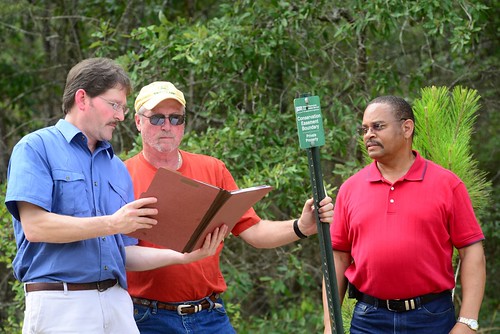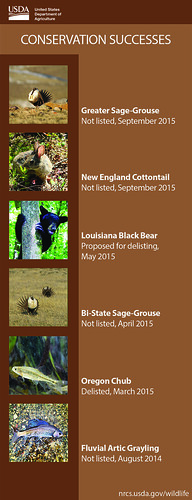
Seventy percent of the land in the lower 48 states is privately owned, home to productive working farms, ranches and forests that account for much of our nation’s open space and wildlife habitat. For 80 years USDA’s Natural Resources Conservation Service has worked side-by-side with America’s agricultural producers to help them manage their land so that they’re conserving natural resources while maintaining the productivity and profitability of their operations.
Launched in 2012, the Working Lands for Wildlife (WLFW) partnership uses this win-win approach to systematically target conservation efforts to improve agricultural productivity while enhancing wildlife habitat in landscapes that are home to seven focal species.
Looking at the bigger picture, we are facing significant challenges. Right now we have more than 7 billion people on the planet. And we’ll have about 9.7 billion by 2050. In the next 40 years farmers and ranchers will have to produce as much food as they have in the last 500. So, how do we raise enough food while balancing the needs of wildlife and natural resources?
Agricultural producers are part of the solution to the challenge. Private lands conservation and partnerships make it possible for us to maintain healthy, productive working lands while also improving the quality of natural resources and wildlife habitat.
The success of private lands conservation was evident this year when we witnessed how it played a crucial role in the rebound of species across the country—from the Louisiana black bear to the Oregon chub, and from the New England cottontail to the fluvial Arctic grayling. Ranchers have also been able to preserve the Western way of life and improve agricultural production while safeguarding the greater sage-grouse.
The U.S. Fish and Wildlife Service (FWS) determined earlier this year that protections under the Endangered Species Act (ESA) were not warranted for sage grouse, largely due to the success of targeted voluntary conservation work on private lands where ranchers made conservation improvements to 4.4 million acres.
More habitat restoration is on the way. NRCS is investing $211 million in sage grouse conservation from 2015 to 2018, the remaining years of the 2014 Farm Bill. As part of that effort, we have announced about $40 million available in 2016 for ranchers in 11 Western states interested in partnering with us to improve their lands while aiding the bird.
Our sage grouse efforts, launched in 2010, became the model for WLFW, which focuses on habitat restoration for sage grouse, New England cottontail, lesser prairie-chicken, gopher tortoise, southwestern willow flycatcher, golden-winged warbler and bog turtle. Collectively, we’re making available $50 million to leverage additional private investment by producers in 2016 in these species’ targeted ecosystems.
And we know when ranchers enhance and protect sagebrush habitat for sage grouse, hundreds of other species benefit. Data released earlier this year shows that habitat restoration in Oregon led to tremendous population jumps in two sagebrush songbirds, both designated as species of concern by FWS.
The impacts of a healthy ecosystem have a ripple effect, benefitting wildlife, fish, insects, water, air, soil, working lands and rural economies. We’ll continue to provide producers with the tools they need, through technical expertise and financial assistance, to make conservation improvements.
Producers interested in NRCS technical and financial assistance are encouraged to contact their local USDA service center.



